Until the last few years, massive transfusion in trauma consisted of component therapy, an admixture of packed red cells, plasma, and platelets. Whole blood transfusion is making inroads again, but it is used in a minority of centers.
Of the three components, platelets have classically required different handling than the others. They are generally kept at room temperature, while the red cells and plasma are kept very cold to preserve their shelf life. A few centers have toyed with the use of cold platelets, but there have been concerns about their ability to clot and their useful life after transfusion.
Researchers from the US Army performed a retrospective registry study on a sample of military casualties over four years. They identified soldiers who received either room-temperature or cold-stored platelets. The primary outcome was mortality, and secondary outcomes included the need for surgery, fluid and blood infusions, and the use of a massive transfusion protocol.
Here are the factoids:
- A total of 300 patients were identified, nearly equally split between room temp platelets and cold-stored
- Demographics of the two groups were similar, but the ISS was somewhat higher in the cold-stored platelet group
- Significantly fewer cold-stored platelet patients underwent surgery (13% vs. 24%)
- Survival was the same at 87-88%
- Blood and product administration was significantly higher in the cold-stored group, as was the use of the MTP (54% vs. 34%)
The authors concluded that the use of cold-stored platelets were not inferior to room temperature platelets.
Bottom line: Huh?? Yes, survival was the same despite a higher ISS in the cold platelet group. But they required more blood and needed massive transfusion significantly more often.
I see two major issues with this study. The most important is that it is a non-inferiority study. To believe that both arms are equal, a power analysis is required. The sample size here is too small to achieve significance unless differences are extreme, like the transfusion and MTP numbers.
The second problem is that this is an association study. Attempting to show that the type of platelets used is a major determinant of survival, need for surgery, or blood product use is shortsighted. There are a myriad of other factors that have more of an impact.
Far more subjects need to be studied, and a retrospective study with limited data points is not enough. I’m surprised that a military registry could only come up with 75 patients a year to analyze. These low numbers and the nature of this particular registry could inject significant bias as well.
Stay with the room temp platelets for now, and wait for a well-powered prospective analysis before changing your MTP.
Reference: An analysis of the use of cold-stored platelets in combat trauma. AAST 2023 Plenary paper #29.


